2009 BMW 135I CONVERTIBLE automatic transmission
[x] Cancel search: automatic transmissionPage 100 of 166
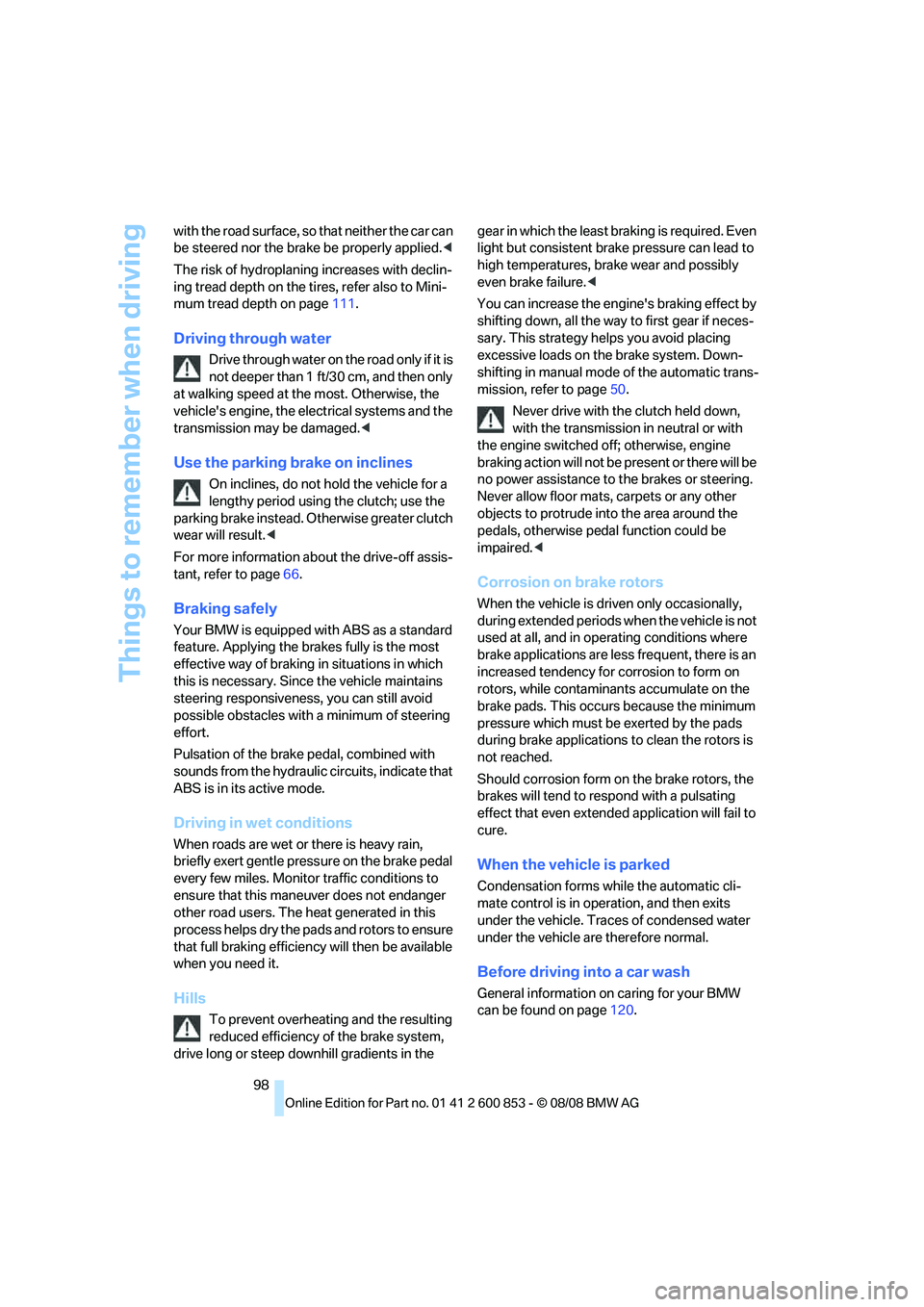
Things to remember when driving
98 with the road surface, so that neither the car can
be steered nor the brake be properly applied.<
The risk of hydroplaning increases with declin-
ing tread depth on the tires, refer also to Mini-
mum tread depth on page111.
Driving through water
Drive through water on the road only if it is
not deeper than 1 ft/30 cm, and then only
at walking speed at the most. Otherwise, the
vehicle's engine, the electrical systems and the
transmission may be damaged.<
Use the parking brake on inclines
On inclines, do not hold the vehicle for a
lengthy period using the clutch; use the
parking brake instead. Otherwise greater clutch
wear will result.<
For more information about the drive-off assis-
tant, refer to page66.
Braking safely
Your BMW is equipped with ABS as a standard
feature. Applying the brakes fully is the most
effective way of braking in situations in which
this is necessary. Since the vehicle maintains
steering responsiveness, you can still avoid
possible obstacles with a minimum of steering
effort.
Pulsation of the brake pedal, combined with
sounds from the hydraulic circuits, indicate that
ABS is in its active mode.
Driving in wet conditions
When roads are wet or there is heavy rain,
briefly exert gentle pressure on the brake pedal
every few miles. Monitor traffic conditions to
ensure that this maneuver does not endanger
other road users. The heat generated in this
process helps dry the pads and rotors to ensure
that full braking efficiency will then be available
when you need it.
Hills
To prevent overheating and the resulting
reduced efficiency of the brake system,
drive long or steep downhill gradients in the gear in which the least braking is required. Even
light but consistent brake pressure can lead to
high temperatures, brake wear and possibly
even brake failure.<
You can increase the engine's braking effect by
shifting down, all the way to first gear if neces-
sary. This strategy helps you avoid placing
excessive loads on the brake system. Down-
shifting in manual mode of the automatic trans-
mission, refer to page50.
Never drive with the clutch held down,
with the transmission in neutral or with
the engine switched off; otherwise, engine
braking action will not be present or there will be
no power assistance to the brakes or steering.
Never allow floor mats, carpets or any other
objects to protrude into the area around the
pedals, otherwise pedal function could be
impaired.<
Corrosion on brake rotors
When the vehicle is driven only occasionally,
during extended periods when the vehicle is not
used at all, and in operating conditions where
brake applications are less frequent, there is an
increased tendency for corrosion to form on
rotors, while contaminants accumulate on the
brake pads. This occurs because the minimum
pressure which must be exerted by the pads
during brake applications to clean the rotors is
not reached.
Should corrosion form on the brake rotors, the
brakes will tend to respond with a pulsating
effect that even extended application will fail to
cure.
When the vehicle is parked
Condensation forms while the automatic cli-
mate control is in operation, and then exits
under the vehicle. Traces of condensed water
under the vehicle are therefore normal.
Before driving into a car wash
General information on caring for your BMW
can be found on page120.
Page 101 of 166

Reference
At a glance
Controls
Driving tips
Mobility
99
With convenient access and automatic
transmission
Insert the remote control into the ignition
switch.
The engine can be switched off when the selec-
tor lever is in position N. Refer also to page27.
Cargo loading
To avoid loading the tires beyond their
approved carrying capacity, never over-
load the vehicle. Overloading can lead to over-
heating and increases the rate at which damage
develops inside the tires. This can ultimately
result in a sudden blow-out.<
Make sure that no liquids are spilled or
leak from their containers in the cargo
bay, as this could result in damage to the vehi-
cle.<
Determining loading limit
1.Locate the following statement on your
vehicle's placard
*:
The combined weight of occupants
and cargo should never exceed
XXX kg or YYY lbs. Otherwise, overloading
can result in damage to the vehicle and
unstable driving conditions.<
2.Determine the combined weight of the
driver and passengers that will be riding in
your vehicle.
3.Subtract the combined weight of the driver
and passengers from XXX kilograms or YYY
pounds.
4.The resulting figure equals the available
amount of cargo and luggage load capacity. For example, if the YYY amount equals
1,400 lbs. and there will be five 150-lb. pas-
sengers in your vehicle, the amount of avail-
able cargo and luggage load capacity is
650 lbs:
1,400 lbs. minus 750 lbs. = 650 lbs.
5.Determine the combined weight of luggage
and cargo being loaded on the vehicle. That
weight may not safely exceed the available
cargo and luggage load capacity calculated
in step 4.
6.If your vehicle will be towing a trailer, part of
the load from your trailer will be transferred
to your vehicle. Consult the manual for
transporting a trailer to determine how this
may reduce the available cargo and luggage
load capacity of your vehicle.
Load
The permissible load is the total of the weight of
occupants and cargo/luggage. The greater the
weight of the occupants, the less cargo/lug-
gage can be transported.
Stowing cargo
Coupe
Page 122 of 166
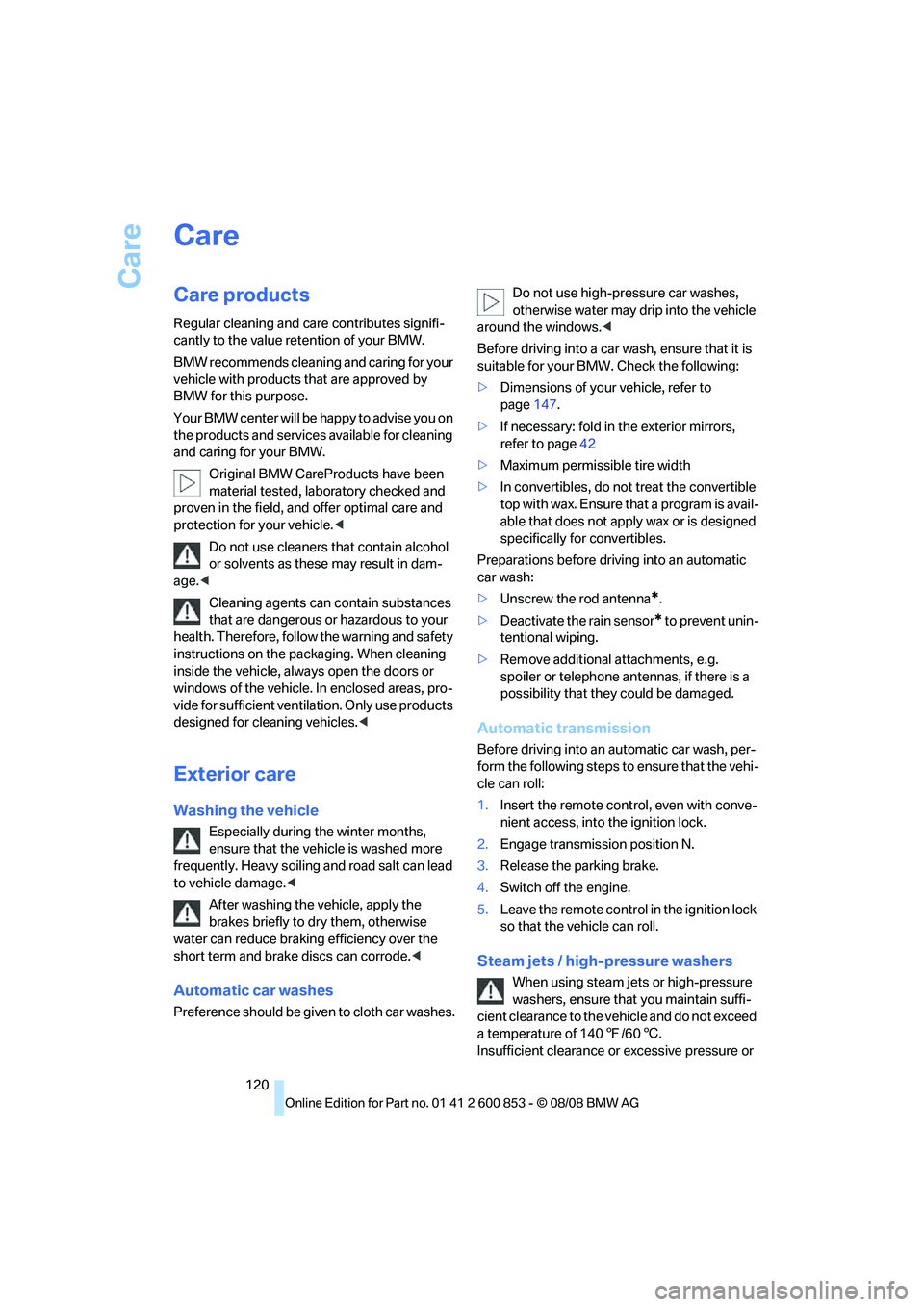
Care
120
Care
Care products
Regular cleaning and care contributes signifi-
cantly to the value retention of your BMW.
BMW recommends cleaning and caring for your
vehicle with products that are approved by
BMW for this purpose.
Your BMW center will be happy to advise you on
the products and services available for cleaning
and caring for your BMW.
Original BMW CareProducts have been
material tested, laboratory checked and
proven in the field, and offer optimal care and
protection for your vehicle.<
Do not use cleaners that contain alcohol
or solvents as these may result in dam-
age.<
Cleaning agents can contain substances
that are dangerous or hazardous to your
health. Therefore, follow the warning and safety
instructions on the packaging. When cleaning
inside the vehicle, always open the doors or
windows of the vehicle. In enclosed areas, pro-
vide for sufficient ventilation. Only use products
designed for cleaning vehicles.<
Exterior care
Washing the vehicle
Especially during the winter months,
ensure that the vehicle is washed more
frequently. Heavy soiling and road salt can lead
to vehicle damage.<
After washing the vehicle, apply the
brakes briefly to dry them, otherwise
water can reduce braking efficiency over the
short term and brake discs can corrode.<
Automatic car washes
Preference should be given to cloth car washes.Do not use high-pressure car washes,
otherwise water may drip into the vehicle
around the windows.<
Before driving into a car wash, ensure that it is
suitable for your BMW. Check the following:
>Dimensions of your vehicle, refer to
page147.
>If necessary: fold in the exterior mirrors,
refer to page42
>Maximum permissible tire width
>In convertibles, do not treat the convertible
top with wax. Ensure that a program is avail-
able that does not apply wax or is designed
specifically for convertibles.
Preparations before driving into an automatic
car wash:
>Unscrew the rod antenna
*.
>Deactivate the rain sensor
* to prevent unin-
tentional wiping.
>Remove additional attachments, e.g.
spoiler or telephone antennas, if there is a
possibility that they could be damaged.
Automatic transmission
Before driving into an automatic car wash, per-
form the following steps to ensure that the vehi-
cle can roll:
1.Insert the remote control, even with conve-
nient access, into the ignition lock.
2.Engage transmission position N.
3.Release the parking brake.
4.Switch off the engine.
5.Leave the remote control in the ignition lock
so that the vehicle can roll.
Steam jets / high-pressure washers
When using steam jets or high-pressure
washers, ensure that you maintain suffi-
cient clearance to the vehicle and do not exceed
a temperature of 1407/606.
Insufficient clearance or excessive pressure or
Page 135 of 166

Reference
At a glance
Controls
Driving tips
Mobility
133
is not active and it will be necessary to turn the
steering wheel further.<
Manual transmission
Gearshift lever in neutral position.
Automatic transmission
Selector lever in position N.
Changing the selector lever position, refer to
page50.
Do not exceed a towing speed of 45 mph/
70 km/h and a towing distance of
90 miles/150 km, otherwise the automatic
transmission may be damaged.<
Towing methods
Do not lift the vehicle by a tow fitting or
body and chassis parts, otherwise dam-
age may result.<
With a tow bar
The towing vehicle must not be lighter
than the towed vehicle, otherwise it may
be impossible to maintain control.<
The tow fittings used should be on the same
side on both vehicles. Should it prove impossi-
ble to avoid mounting the tow bar at an angle,
please observe the following:
>Clearance and maneuvering capability will
be sharply limited during cornering.
>The tow bar will generate lateral forces if it is
attached offset.
Attach the tow bar to the tow fittings only,
as attaching it to other parts of the vehicle
could result in damage.<
With a tow rope
When starting off in the towing vehicle, make
sure that the tow rope is taut.
To avoid jerking and the associated
stresses on vehicle components when
towing, always use nylon ropes or nylon straps.
Attach the tow rope to the tow fittings only, as
attaching it to other parts of the vehicle could
result in damage.<
With a tow truck
Have the BMW transported with a tow truck
with a so-called lift bar or on a flat bed.
Do not tow the vehicle with just the rear axle
raised as this may cause the steering to turn.
Tow-starting
Avoid tow-starting the vehicle whenever possi-
ble; instead, jump-start the engine, refer to
page131. Vehicles with a catalytic converter
should only be tow-started when the engine is
cold, vehicles with an automatic transmission
cannot be tow-started at all.
1.Switch on the hazard warning flashers,
comply with local regulations.
2.Switch on the ignition, refer to page47.
3.Shift into 3rd gear.
4.Have the vehicle tow-started with the clutch
depressed all the way and slowly release
the clutch. After the engine starts, immedi-
ately depress the clutch completely again.
5.Stop at a suitable location, remove the tow
bar or rope and switch off the hazard warn-
ing flashers.
6.Have the vehicle checked.
Page 143 of 166
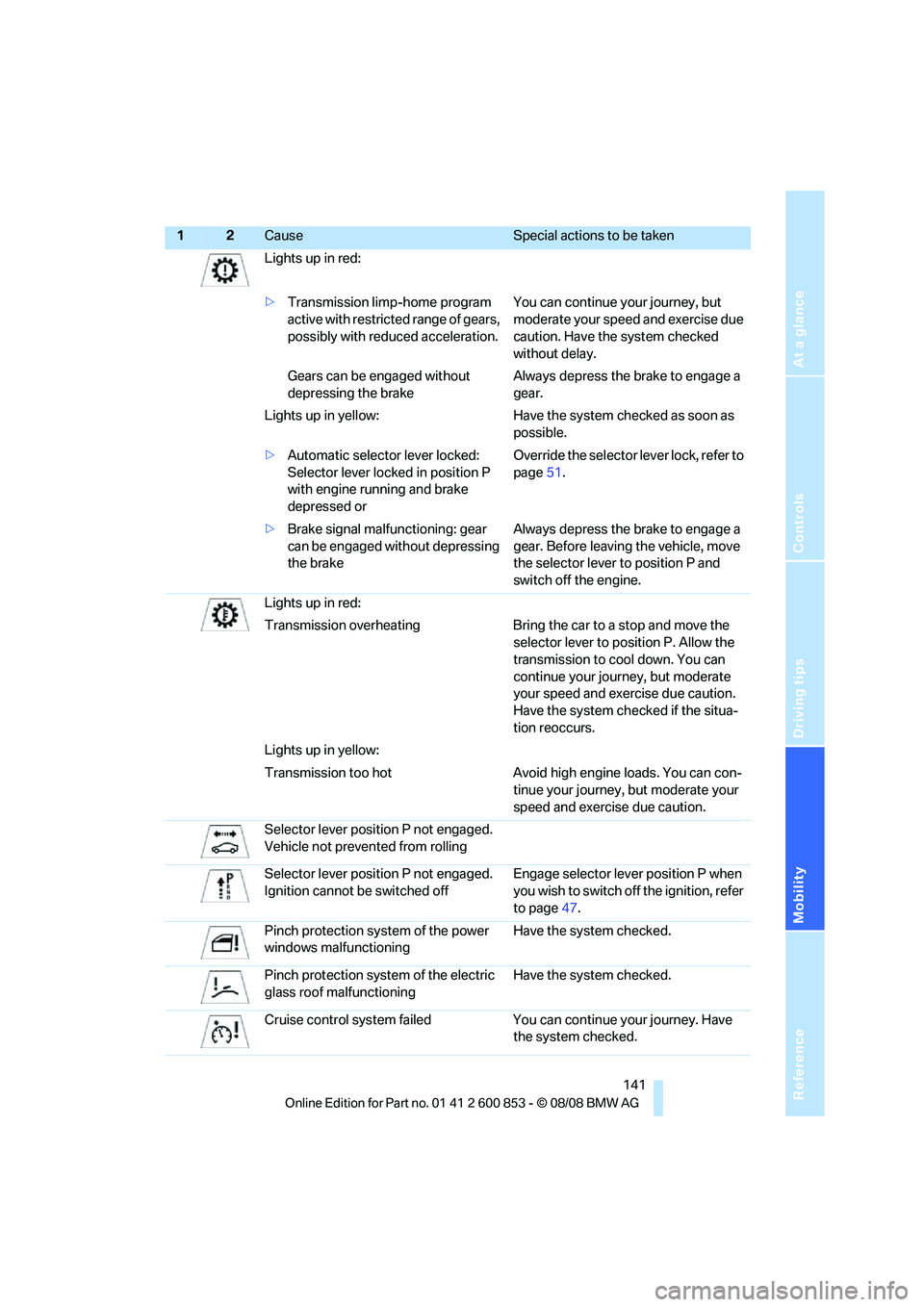
Reference
At a glance
Controls
Driving tips
Mobility
141
Lights up in red:
>Transmission limp-home program
active with restricted range of gears,
possibly with reduced acceleration. You can continue your journey, but
moderate your speed and exercise due
caution. Have the system checked
without delay.
Gears can be engaged without
depressing the brakeAlways depress the brake to engage a
gear.
Lights up in yellow: Have the system checked as soon as
possible.
>Automatic selector lever locked:
Selector lever locked in position P
with engine running and brake
depressed orOverride the selector lever lock, refer to
page51.
>Brake signal malfunctioning: gear
can be engaged without depressing
the brakeAlways depress the brake to engage a
gear. Before leaving the vehicle, move
the selector lever to position P and
switch off the engine.
Lights up in red:
Transmission overheating Bring the car to a stop and move the
selector lever to position P. Allow the
transmission to cool down. You can
continue your journey, but moderate
your speed and exercise due caution.
Have the system checked if the situa-
tion reoccurs.
Lights up in yellow:
Transmission too hot Avoid high engine loads. You can con-
tinue your journey, but moderate your
speed and exercise due caution.
Selector lever position P not engaged.
Vehicle not prevented from rolling
Selector lever position P not engaged.
Ignition cannot be switched offEngage selector lever position P when
you wish to switch off the ignition, refer
to page47.
Pinch protection system of the power
windows malfunctioningHave the system checked.
Pinch protection system of the electric
glass roof malfunctioningHave the system checked.
Cruise control system failed You can continue your journey. Have
the system checked.
12Cause Special actions to be taken
Page 151 of 166
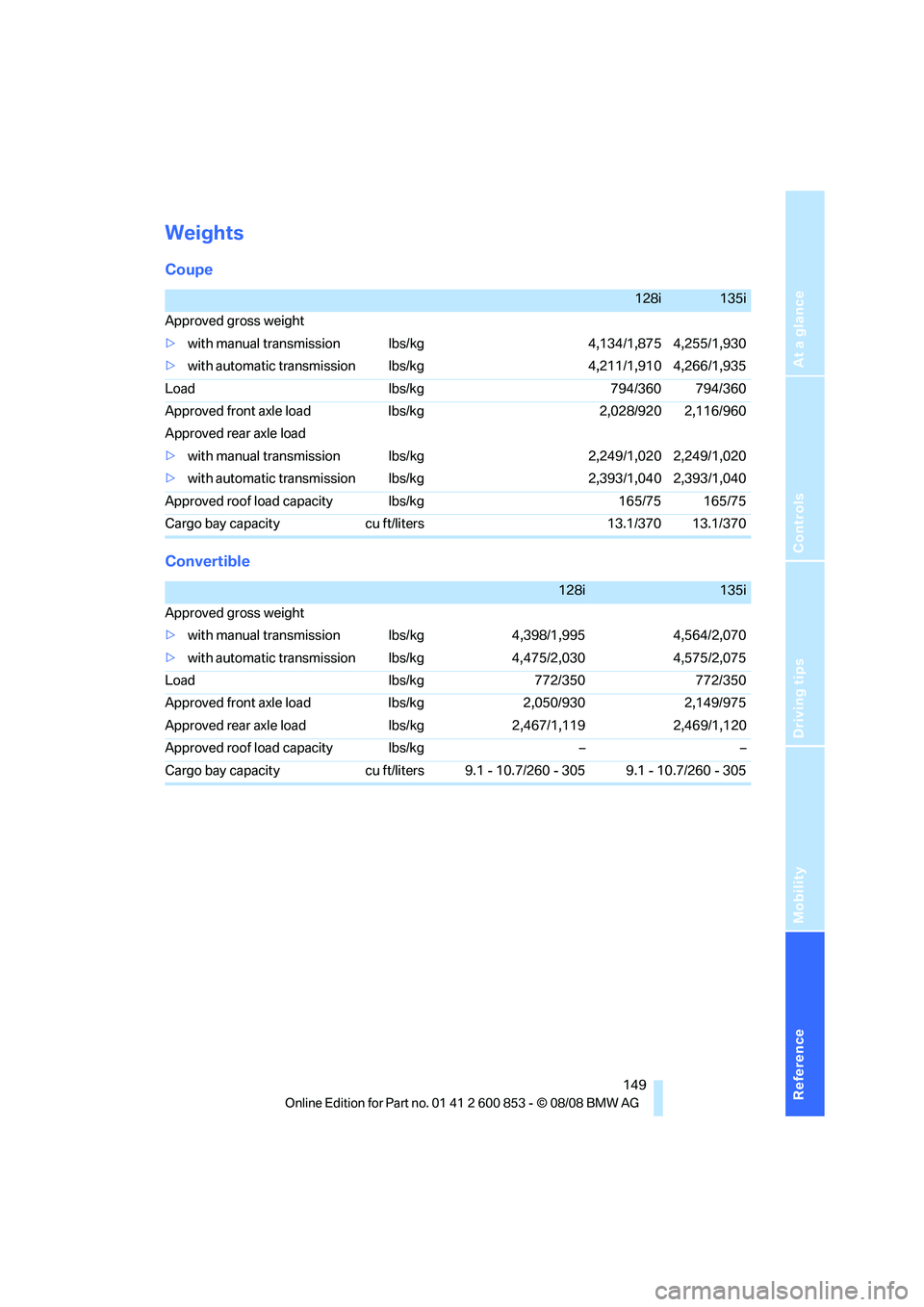
Reference
At a glance
Controls
Driving tips
Mobility
149
Weights
Coupe
Convertible
128i135i
Approved gross weight
>with manual transmission lbs/kg 4,134/1,875 4,255/1,930
>with automatic transmission lbs/kg 4,211/1,910 4,266/1,935
Load lbs/kg 794/360 794/360
Approved front axle load lbs/kg 2,028/920 2,116/960
Approved rear axle load
>with manual transmission lbs/kg 2,249/1,020 2,249/1,020
>with automatic transmission lbs/kg 2,393/1,040 2,393/1,040
Approved roof load capacity lbs/kg 165/75 165/75
Cargo bay capacity cu ft/liters 13.1/370 13.1/370
128i135i
Approved gross weight
>with manual transmission lbs/kg 4,398/1,995 4,564/2,070
>with automatic transmission lbs/kg 4,475/2,030 4,575/2,075
Load lbs/kg 772/350 772/350
Approved front axle load lbs/kg 2,050/930 2,149/975
Approved rear axle load lbs/kg 2,467/1,119 2,469/1,120
Approved roof load capacity lbs/kg – –
Cargo bay capacity cu ft/liters 9.1 - 10.7/260 - 305 9.1 - 10.7/260 - 305
Page 154 of 166

Everything from A to Z
152
Everything from A to Z
Index
A
ABS Antilock Brake
System64
Accessories, refer to The
individual vehicle5
Accident, reporting, refer to
Emergency Request130
Activated-charcoal filter84
Active steering70
Adaptive Head Light76
Additives
– coolant117
– engine oil116
Airbags71
– sitting safely35
– warning lamp72
Air conditioner79
Air distribution
– automatic83
– individual80
Air flow rate80,83
Airing, refer to
Ventilation81,84
Air outlets, refer to Air
vents79
Air pressure, checking, refer
to Tire inflation
pressure106
Air recirculation, refer to
Recirculated-air
mode80,83
Air vents79
AKI, refer to Fuel
specifications104
Alarm system24
– avoiding unintentional
alarms25
– interior motion sensor25
– switching off an alarm25
– tilt alarm sensor25
All-season tires, refer to
Winter tires113Ambient air, refer to
Recirculated-air
mode80,83
Antifreeze
– coolant117
– washer fluid53
Antilock Brake System
ABS64
Anti-theft alarm system, refer
to Alarm system24
Anti-theft system19
Approved axle loads, refer to
Weights149
Approved gross vehicle
weight, refer to Weights149
Armrest, refer to Center
armrest
88
Ashtray90
Assistance systems, refer to
Dynamic Stability Control
DSC65
AUC Automatic recirculated-
air control83
Automatic
– air distribution83
– air flow rate83
– cruise control54
– headlamp control74
Automatic car wash, refer to
Car wash98
Automatic car washes120
Automatic climate control79
– automatic air distribution83
Automatic curb monitor42
Automatic lamps
– refer to Welcome lamps74
Automatic recirculated-air
control AUC83Automatic transmission with
Steptronic49
– interlock50
– selector lever lock50
– shiftlock50
– towing132
– tow-starting132
AUTO program for automatic
climate control83
Average fuel consumption58
– setting the units60
Average speed58
Avoiding unintentional
alarms25
Axle loads, refer to
Weights149
B
Backrests, refer to Seats36
Backrest width adjustment37
Back seats, refer to Rear seats
– adjusting head restraints38
Backup lamp, replacing
bulb127
Bag for skis, refer to Ski
bag92
Band-aids, refer to First-aid
pouch130
Bar, refer to Tow-starting,
towing away133
Battery128
– charging128
– disposal27,128
– jump starting131
– temporary power failure128
Battery renewal
– remote control for vehicle27
Being towed132
Belts, refer to Safety belts41
Belt tensioner, refer to Safety
belts41
Page 157 of 166
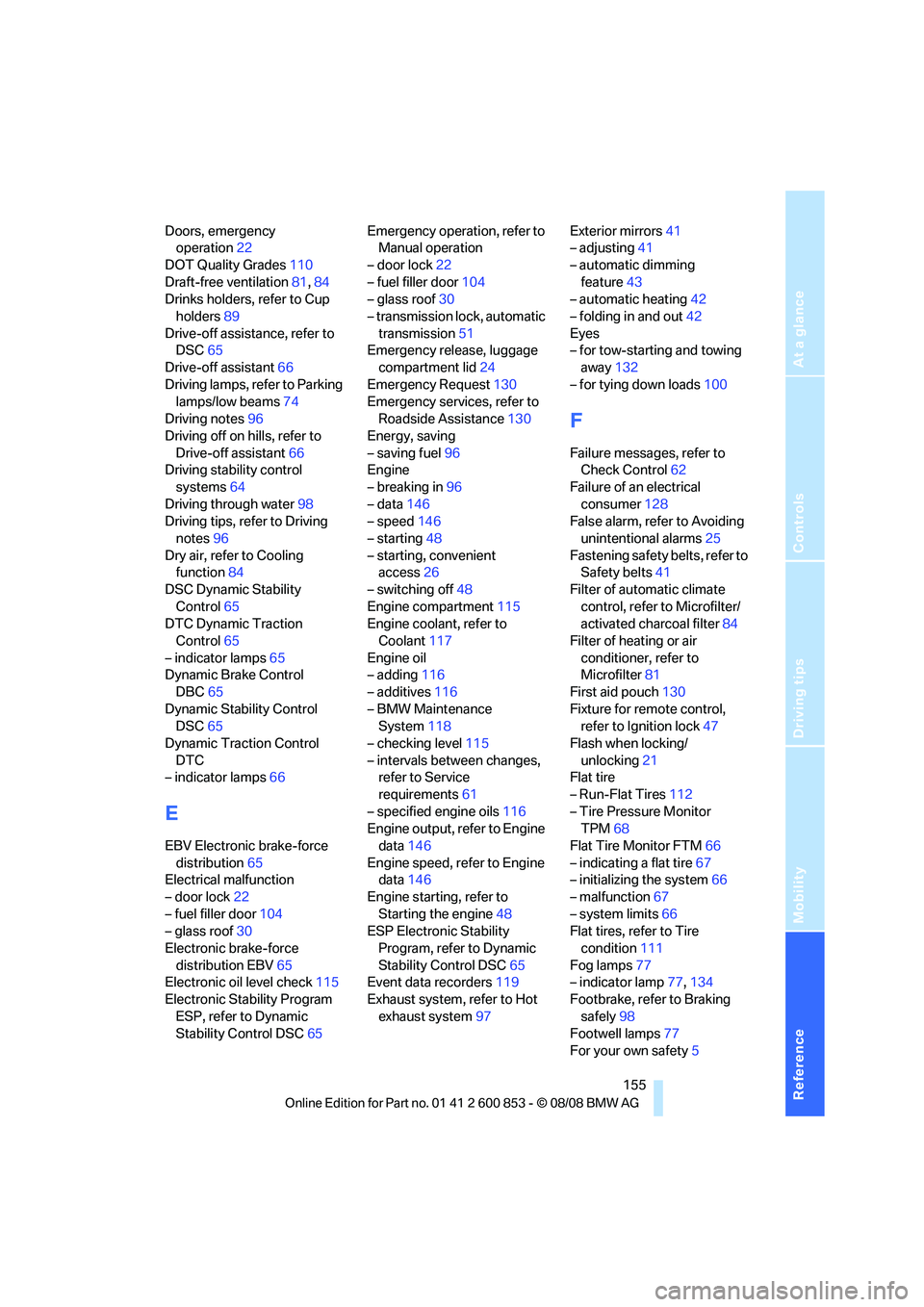
Reference
At a glance
Controls
Driving tips
Mobility
155
Doors, emergency
operation22
DOT Quality Grades110
Draft-free ventilation81,84
Drinks holders, refer to Cup
holders89
Drive-off assistance, refer to
DSC65
Drive-off assistant66
Driving lamps, refer to Parking
lamps/low beams74
Driving notes96
Driving off on hills, refer to
Drive-off assistant66
Driving stability control
systems64
Driving through water98
Driving tips, refer to Driving
notes96
Dry air, refer to Cooling
function84
DSC Dynamic Stability
Control65
DTC Dynamic Traction
Control65
– indicator lamps65
Dynamic Brake Control
DBC65
Dynamic Stability Control
DSC65
Dynamic Traction Control
DTC
– indicator lamps66
E
EBV Electronic brake-force
distribution65
Electrical malfunction
– door lock22
– fuel filler door104
– glass roof30
Electronic brake-force
distribution EBV65
Electronic oil level check115
Electronic Stability Program
ESP, refer to Dynamic
Stability Control DSC65Emergency operation, refer to
Manual operation
– door lock22
– fuel filler door104
– glass roof30
– transmission lock, automatic
transmission51
Emergency release, luggage
compartment lid24
Emergency Request130
Emergency services, refer to
Roadside Assistance130
Energy, saving
– saving fuel96
Engine
– breaking in96
– data146
– speed146
– starting48
– starting, convenient
access26
– switching off48
Engine compartment115
Engine coolant, refer to
Coolant117
Engine oil
– adding116
– additives116
– BMW Maintenance
System118
– checking level115
– intervals between changes,
refer to Service
requirements61
– specified engine oils116
Engine output, refer to Engine
data146
Engine speed, refer to Engine
data146
Engine starting, refer to
Starting the engine48
ESP Electronic Stability
Program, refer to Dynamic
Stability Control DSC65
Event data recorders119
Exhaust system, refer to Hot
exhaust system97Exterior mirrors41
– adjusting41
– automatic dimming
feature43
– automatic heating42
– folding in and out42
Eyes
– for tow-starting and towing
away132
– for tying down loads100
F
Failure messages, refer to
Check Control62
Failure of an electrical
consumer128
False alarm, refer to Avoiding
unintentional alarms25
Fastening safety belts, refer to
Safety belts41
Filter of automatic climate
control, refer to Microfilter/
activated charcoal filter84
Filter of heating or air
conditioner, refer to
Microfilter81
First aid pouch130
Fixture for remote control,
refer to Ignition lock47
Flash when locking/
unlocking21
Flat tire
– Run-Flat Tires112
– Tire Pressure Monitor
TPM68
Flat Tire Monitor FTM66
– indicating a flat tire67
– initializing the system66
– malfunction67
– system limits66
Flat tires, refer to Tire
condition111
Fog lamps77
– indicator lamp77,134
Footbrake, refer to Braking
safely98
Footwell lamps77
For your own safety5